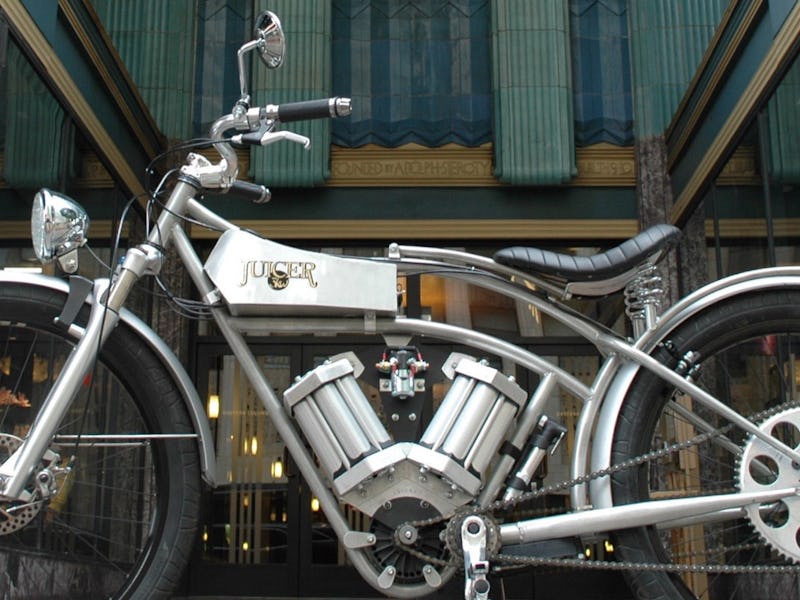Juicer's Futuristic Electric Motorcycles Look 100 Years Old
"I emulate bikes from 100 years ago, the 1910s."

David Twomey may have pulled off something unthinkable. He’s made a cool electric motor bicycle. Los Angeles-based Juicer, a tiny firm that started in 2010, only makes two bikes per year, but those machines are turning heads wherever they go. In many cases, people have no idea it’s an electric bike.
“Too often in the past, there’s been a divide between left-wing, dorky but clean transportation, and the motivator for those customers is, ‘I’m doing something right for the planet,’ and then right-wing, gas-guzzling hot rods, and they’re like, ‘I’m serving my image of masculinity,’” Twomey says. “Juicer does both.”
In many ways, Twomey’s ambitions are reminiscent of Tesla’s original goal. The first master plan unveiled in 2006 explained that the company’s first car, the Roadster, was a premium car aimed at the high end of the market. No compromises, competing with the Ferraris and the Porsches of the elite without looking … weird. Twomey, like Musk all those years ago, is proving electric vehicles don’t have to look like a lab experiment.
“I’ve gotten my bikes into the Easy Rider motorcycle show, and I don’t think they even knew it was an electric bike!” Twomey says. “But I’m able to appeal to red-state Americans, because when they see my bike, they say ‘ah, that’s a cool bike,’ they don’t say, ‘oh that’s a clean bike.’”
These are powerful bikes, too. Where many of its kind come with 350-watt hours, Juicer bikes clock in around 720-watt hours. The top speed is 30 mph. The cheapest is priced around $4,000, while the most expensive runs to $10,000.
“I emulate bikes from 100 years ago, the 1910s,” Twomey says. He takes his inspiration from the board track era of racing, as today’s electric bikes have a comparable power-to-weight ratio:
A 1912 Indian Board Track Racer that inspired Twomey.
That means custom-made frames designed to accommodate larger gas engines, jack shafts, and sheaths for the belt drive. “Those all make sense again, and they help give the bike classic appeal that just hasn’t shown up in the EV segment yet,” Twomey says.
Although a relatively small operation for now (Twomey is the only employee), Juicer has received a large amount of interest from potential backers. The bikes made an appearance at this year’s LA Auto Show, and Twomey has started working with the Los Angeles Cleantech Incubator (LACI) as a portfolio company. The incubator doesn’t directly invest money, but provides networking, support, and resources to give businesses a leg up.
“Juicer was selected because they provide an alternative to commuting that is both non-polluting and iconic, as well as unique in design,” Laurie Peter, LACI communications director, tells Inverse.
The unique designs are getting a big thumbs up from the experts:
“My favorite thing about it is the fact that I’m riding a functional piece of art,” Gregory Reynoso, a teacher at a middle school and owner of a Citizen 36v, tells Inverse. He’s owned the bike for just over a year, and uses it to ride the 13 miles to work two to three times a week, where “everyone really digs it.” Compared to a gas-powered bike, he finds the Citizen is near-silent even when in use. “People stop me all the time to ask about it, take pictures, and I get a lot of thumbs up.”
“My other favorite thing about it is the fact that I feel about 10 years younger when zipping around traffic during rush hour,” Reynoso says.
A couple of bikes every year may sound like a nice hobby, but Twomey isn’t stopping there. He’s started using the LACI’s advanced prototyping center, unveiled in November, to improve the bikes. There, he has access to a number of high-end tools to hand, like 3D printers, chemistry labs, and laser cutters. He’s also looking for people to join him on his mission: engineers, investors, strategic partners — anyone who wants to help him achieve his goal of making electric bikes cool.
“We had electric cars 100 years ago, but because of the gap between then and the second wave, there was never any slow growth,” Twomey says. “When the second wave came we got a lot of awkward designs. I see myself as filling in that fossil record.”